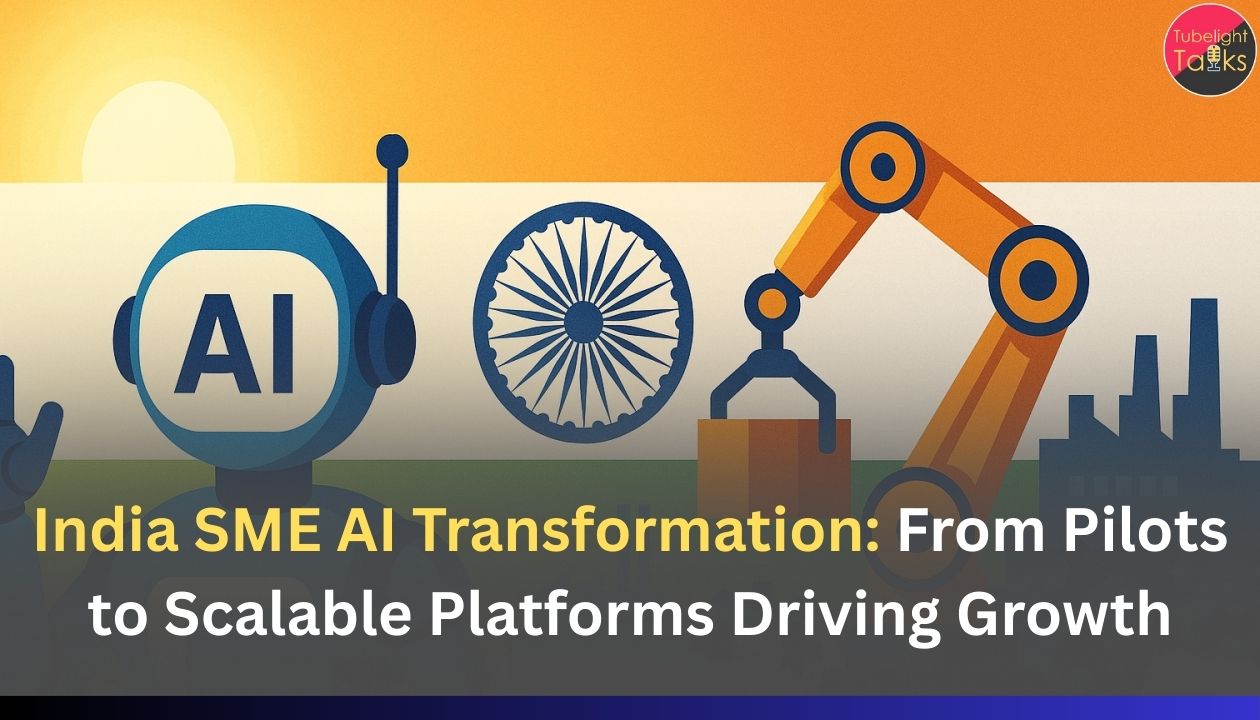India SME AI Transformation has accelerated rapidly between 2024 and 2026, as small and medium-sized enterprises moved beyond basic AI experiments to fully integrating scalable, AI-enabled platforms across their operations. This shift allowed SMEs to overcome long-standing challenges such as limited access to formal credit and low productivity.
By using AI-driven tools for risk assessment, market intelligence, supply chain optimization, and customer engagement, SMEs significantly improved efficiency, reduced operational costs, and unlocked new financing opportunities—ushering in a pivotal era of enhanced competitiveness and long-term sustainability.
Bridging the Credit Gap Through AI Innovation
AI-Driven Credit Scoring and Financing Platforms
India’s SMEs have long struggled with accessing affordable credit due to lack of traditional financial documentation and high perceived risks by lenders. AI platforms emerged to fill this void by utilizing alternative data—including digital transaction history, social media signals, and real-time financial analytics—to assess creditworthiness. This innovation expanded formal credit penetration and shortened loan approval times dramatically, cutting reliance on informal and costly financing.
Impact on Financing Costs and Access
Lower credit costs and quicker processing have enabled SMEs to invest in technology, inventory, and workforce, directly boosting productivity. For many businesses, AI-driven credit models reduced financial exclusion that historically suppressed growth opportunities.
Enhancing SME Productivity With AI Tools
Automation and Analytics-Enabled Efficiency
SMEs adopted AI tools like process automation bots, predictive analytics for demand forecasting, and AI-powered customer service chatbots to streamline operations. This led to productivity gains between 15 to 30 percent, reducing manual workloads and improving decision-making speed.
Sectoral Adoption Patterns
Retail, manufacturing, agriculture, and services sectors demonstrated high AI uptake, especially tools tailored to inventory management, quality control, and user engagement. The result was improved revenue per employee and overall business resilience.
Scaling AI from Pilot Projects to Industry Platforms
Overcoming Initial Barriers
Early pilot projects often faltered due to cost, skill gaps, and infrastructural limitations. However, collaborative efforts between government initiatives, industry coalitions, and technology providers led to development of affordable, easy-to-use platforms designed specifically for India’s diverse SME ecosystem.
The Role of Government and Ecosystem Players
Programs offering subsidies, training, and digital infrastructure laid the foundation for widespread adoption. Partnerships also facilitated knowledge transfer and spread of best practices enabling sustained platform usage beyond pilots.
Embracing Change and Ethical Growth
Sant Rampal Ji Maharaj inspires individuals and businesses to pursue progress grounded in truth, righteousness, and social responsibility. The SME sector’s AI adoption journey reflects this spirit—transforming through honest technology use that empowers not only profits but also equitable growth and sustainability. Satgyan calls on all to integrate innovation with ethical values, ensuring that technological progress uplifts communities and respects fairness, integrity, and collective welfare.
Key Facts
- AI adoption among Indian SMEs grew significantly between 2024 and 2026, moving from tests to scalable platforms.
- AI tools helped bridge a $530 billion credit gap by using alternative data for risk evaluation.
- SMEs reported productivity increases of 15-30 percent through AI-powered automation and analytics.
- Government initiatives subsidized AI platforms and training for SME accessibility.
- Retail, manufacturing, agriculture, and services benefited most from AI adoption.
- Formal credit access increased while reliance on informal lending decreased substantially.
Expert Insights on India’s SME AI Revolution
Industry Analysts
Analysts highlight the critical role of affordable, user-friendly AI platforms designed for SMEs in pushing adoption beyond pilots, making digital transformation inclusive and measurable.
Policy Makers and Economists
Experts emphasize sustained collaboration between the private sector, government, and technology providers as essential to closing credit and productivity gaps through AI.
Looking Forward: Sustaining Inclusive AI Growth for SMEs
Continued Capacity Building and Access
Future focus will be on scaling digital literacy, enhancing data availability, and lowering the cost barriers for AI tools to expand coverage across India’s diverse SME base.
Innovation and Market Linkages
AI-driven innovation hubs and fintech collaborations are poised to connect SMEs with global value chains, fostering new business models and export opportunities.
Also Read: India IT-BPM Industry 2026: Rising Toward a Global AI Product Powerhouse
FAQs: India SME AI Transformation
1. How did AI improve credit access?
By using alternative data, AI expanded formal credit assessment and financing options.
2. What productivity gains did SMEs see?
Between 15 and 30 percent increase via automation and analytics.
3. Which sectors adopted AI fastest?
Retail, manufacturing, agriculture, and services.
4. What helped move AI past the pilot stage?
Government support, affordable platforms, and ecosystem partnerships.
5. What does Sant Rampal Ji Maharaj’s Satgyan say about this change?
It advocates for truthful, ethical growth that benefits society as a whole.
This article synthesizes research reports, government data, and expert analyses on AI-driven transformation in Indian SMEs between 2024 and 2026, highlighting inclusive technological progress despite challenges.










